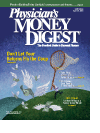Publication
Article
Physician's Money Digest
Establish E-communication with Patients
Author(s):
According to the American Medical Association(AMA), "With the increased usage ofcomputers and the Internet by individuals,e-mail can be a valid, simple, convenient, and inexpensivemechanism for communication. It can aidthe health care delivery process by allowing writtenfollow-up instructions, test results, and disseminationof educational materials for patients, aswell as a means for patients to easily reach theirphysician on routine health matters."
However, for all its ease and satisfaction toboth physicians and patients, it also represents aplethora of new and serious issues—especiallywith the Health Insurance Portability andAccountability Act (HIPAA) now in force.
A 2002 Harris Poll found that more than 70%of patients want e-mail access to their physician'soffice and many would change physicians to getthe service. Aware of this demand, doctors indicatethat liability, security, and compensation aretheir top concerns when offering these services topatients, according to Medem (877-926-3336;www.medem.com), a Web-based physician-practicecommunications network.
Health industry officials agree that technologyadoption among physicians is advancing rapidly,furthering the need for appropriate guidelines andadvice. In 2000, the AMA Board of Trusteesissued guidelines to aid physicians. The guidelines,updated in June 2002, can be found atwww.ama-assn.org/ama/pub/category/2386.html.The following is a summary of the guidelines:
- Establish turnaround time for messages.Exercise caution in using e-mail for urgent matters.
- Inform patients about privacy issues.
- Retain electronic/paper copies of e-mails.
- Establish types of transactions (eg, prescriptionrefill, appointment, etc) and sensitivity ofsubject matter permitted over e-mail.
- Patients should put the "category" of transactionin the subject line.
- Configure an automatic-reply feature onboth physician and patient e-mails.
- Do not send group mailings where recipientsare visible to each other.
- Avoid anger, sarcasm, harsh criticism, andlibelous references to third parties in messages.
- Append a standard block of text to the endof patient e-mail messages, containing the physician'sfull name, contact information, and remindersabout security and the importance of alternativeforms of communication for emergencies.
The AMA also recommends that physicians"develop a patient–physician agreement for theinformed consent for the use of e-mail. Thisshould be discussed with and signed by thepatient and documented in the medical record.Provide patients with a copy of the agreement."
This past December, the AMA's Council onEthical and Judicial Affairs addressed e-mail correspondenceby adopting recommendationsregarding its use, including the following matters:
- E-mail correspondence should not be usedto establish a patient–physician relationship. Itshould supplement other personal encounters.
- When using e-mail communication, physicianshold the same ethical responsibilities to theirpatients as they do during other encounters.
The call for patient–physician e-mail to occursolely within the context of a preexisting relationshipwas also a recent mandate of the eRiskWorking Group for Healthcare. According toeRisk Goup, state boards have taken actionagainst so-called "online doc-in-a-box" services inwhich physicians provide care and prescribe medicationfor patients they have never seen.
The eRisk Group, a consortium of Medem,the AMA, other leading national medical societies,and liability carriers representing over 70%of insured physicians, has been working for 3years to set clear rules for patient–physician onlinecommunication. This past December, theyannounced their new unified guidelines.
Other new guidelines include a warning againstactive solicitation of emergency topics, such aschest pain, shortness of breath, bleeding, etc, oractive solicitation of highly sensitive informationonline.The new guidelines reemphasized the needfor HIPAA compliance and secure online messagingwith authentication and encryption—asopposed to the use of standard e-mail for physicianoffice communications. The eRisk Group alsodeveloped detailed terms-of-service and informed-consentlanguage that educates patients as to theappropriate use of e-mail in health care, while providingadditional liability protection for physicians.These are available at www.medem.com/erisk.
"While increased documentation provided bysecure e-mail with patients can be positive, thenew eRisk guidelines make it clear to physiciansthat there are risks in communicating outside ofpreexisting patient–physician relationships, andin using standard, unencrypted e-mail to communicatewith patients or transmit patient informationto third parties," says Mark Gorney,MD,medical director for The Doctors Company(www.thedoctors.com).
